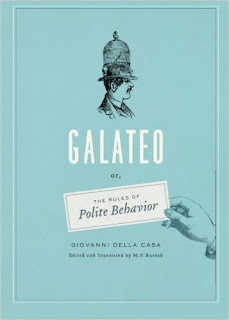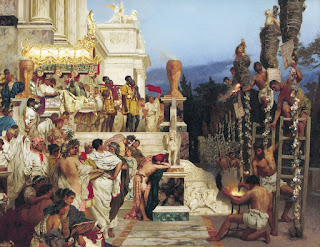Bishop and poet remembered for his manual on etiquette
 |
A portrait of Giovanni della Casa by the
artist Jacopo Pontorno |
Giovanni della Casa, the Tuscan bishop whose witty book on behaviour in polite society became a handbook for generations long after he had passed away, was born on this day in 1503 in Borgo San Lorenzo, 30 kilometres north-east of Florence.
Born into a wealthy family, Della Casa was educated in Bologna and followed his friend, the scholar and poet
Pietro Bembo, into the church.
He became Archbishop of Benevento in 1544 and was nominated by Pope Paul III as Papal
nuncio to Venice. Disappointed at not having been elevated to Cardinal, however, he retired to a life of writing and reading.
At some point between 1551 and 1555, living at an abbey near Treviso, he wrote
Galateo: The Rules of Polite Behaviour, a witty treatise on good manners intended for the amusement of a favourite nephew. He thought it would be regarded as frivolous compared with other books he had written. Little did he know it would become one of the most celebrated books on etiquette in European history.
Published in Venice in 1558, it is considered one of the three great books on Italian conduct, alongside Baldassare Castiglione's
Il Cortegiano, which discusses the qualities required of a 16th century courtier, and Niccolo Machiavelli's
Il Principe (The Prince), which was less about manners than about political pragmatism and achieving objectives.
Della Casa's work goes into considerable detail in describing how to behave without causing offence to others, particularly in the areas of eating, drinking and personal hygiene.
He advised that tearing food apart with the hands and with hunting knifes was vulgar, as a result of which Italians began using dainty forks some two centuries before other European countries. He also cautioned that sniffing another person's wine should be avoided for fear of something unpleasant falling out of one's nose.
 |
Reprints of Della Casa's book, such as this
2013 edition, still sell today |
It was not good form, in his opinion, to spit, yawn or scratch and he cautioned that handwashing should take place in private because, if done in public, those witness to it risked their minds being drawn to thoughts of the bodily functions that might have necessitated it.
One should dress, he proposed, in clothes that conformed to prevailing custom and were reflective of social status and in conversation one should seek to interest all parties present with words that were 'orderly and well-expressed'.
His guidance in other areas could apply to the modern world. It was not good manners, he said, to brag about one's children, or to sing off key. Grooming in public was uncouth and making jokes at the expense of the disabled was unacceptable. And even in an age that could not have imagined telephones, let alone mobile ones, it was rude, he counselled, to read one's mail in company.
However, taking someone to task over their social shortcomings was also considered out of order, unless somehow you could be complimentary at the same time. In short, he advised that people should be pleasant, appropriate and polite in all but the most extreme circumstances.
A Latin scholar, Della Casa is thought to have named the book in honour of
Galeazzo Florimonte, a bishop and man of letters from whom he took his own inspiration. The title entered the Italian language and for a time people who were impolite or crude were said to 'not know the Galateo.'
Della Casa died in Rome in 1556, aged 53. Modern editions of Galateo are still being reprinted today.
Travel tip:
Borgo San Lorenzo is the largest of nine towns and villages that make up the Mugello, a green hilly area overlooking the Sieve valley. The
Medici family have their roots in the Mugello, as does the artist,
Giotto, the most important Italian painter of the 14th century. Its Romanesque Church of San Lorenzo has a belltower dated at 1263. The medieval Palazzo del Podestà was rebuilt in the 1919 earthquake.
 |
| The ruins of the Abbey of Sant'Eustachio near Treviso |
Travel tip:
Little remains now of the
Abbey of Sant'Eustachio, the Benedictine monastery of the early 11th century where Della Casa is thought to have been staying when he wrote Galateo. Situated close to the small town of Nervesa della Battaglia, about 20km from Treviso in the Veneto, it had already been abandoned when it suffered substantial damage during the Battle of the Piave River during the
First World War.
(Photo of the Abbey of Sant'Eustachio by Franco CC BY-SA 2.0)
More reading:
Cosimo II de' Medici - patron of Galileo
Pietro Bembo - poet and scholar who was Lucrezia Borgia's lover
Home










